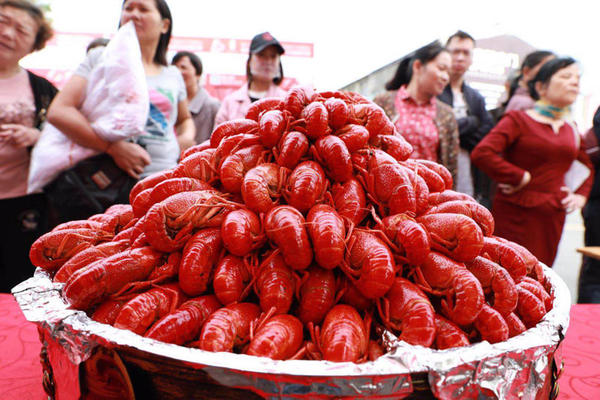County in Central China Feeds Growing Appetite for Crayfish

A festival is held in Jianli county of Central China's Hubei province to promote the delicacy of crayfish. [Photo by Xu Zulin/chinadaily.com.cn]
Chinese people apparently have a great appetite for crayfish.
During a recent festival to promote the delicacy in Jianli county of Central China's Hubei province, over 3,000 people on-site and thousands more through livestreaming witnessed 12 cooks spending more than three hours making 1,491 kilograms of crayfish in a single pot with a diameter of 3.1 meters.
The local government said the county will produce as much as 150,000 metric tons of crayfish this year, compared to 130,000 metric tons in 2018.

More than 1,400 kilograms of crayfish are cooked in a single pot. [Photo by Xu Zulin/chinadaily.com.cn]
Jianli county had been the largest producer of the crustacean among all counties in China for the previous seven consecutive years, said the government, adding that its crayfish is available across China and even the world.
During the 2018 World Cup, crayfish from the county were transported to Russia during the tournament period and snapped up quickly by soccer fans.
Meanwhile, the county is also a major rice producer, with more than 1.28 million metric tons of rice produced in 2018, according to the government.
An increase in crayfish production means more farmland would be used to raise the crustacean. But now crayfish and rice can perfectly coexist.

Jianli county is also a major rice producer. [Photo by Xu Zulin/chinadaily.com.cn]
During the festival held on Monday to promote the production method which allows the coexistence of crayfish and rice, the county's officials said nowadays more than 53,000 hectares of farmland have been used to raise crayfish and grow rice at the same time.

Farmland can be used to raise crayfish and grow rice at the same time in Jianli county. [Photo by Xu Zulin/chinadaily.com.cn]
Crayfish could barely survive with chemical fertilizers or pesticides, which means rice grown in the same water is safer, more delicious and more expensive.
Liu Kun in Wuhan contributed to this story.
